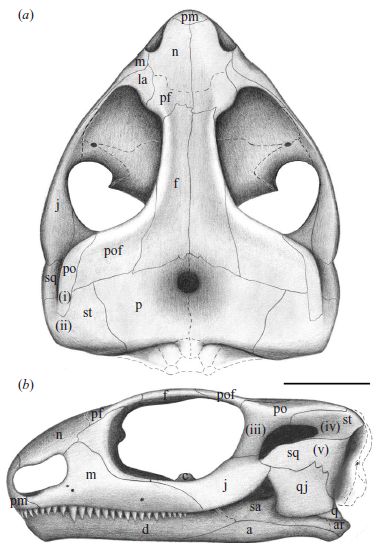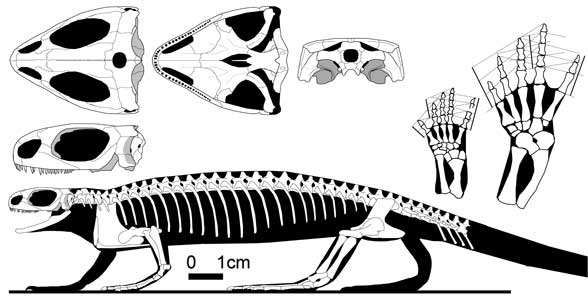
| Anapsida | ||
| The Vertebrates | Procolophonoidea |
| Vertebrates Home | Vertebrate | Vertebrate |
|
Abreviated Dendrogram
Reptiliomorpha
├─Synapsida
└─┬─Eureptilia
│
└─Anapsida
├─┬─Millerettidae
│ └─Eunotosaurus
├─Mesosauridae
└─┬─Lanthanosuchoidea
└─┬─Bolosauridae
└─Procolophonia
├─Nyctiphruretus
├─┬─Nycteroleteridae
│ └─Pareiasauridae
└─Procolophonoidea
├─Owenettidae
│ ├─Barasaurus
│ └─┬─Owenetta
│ └─┬─ Candelaria
│ └─"Owenetta" kitchingorum
├?─Testudines
└─┬─Sauropareion
└─Procolophonidae
├─Procolophoninae
└─Leptopleuroninae
|
Contents
Overview |
P-T.
Procolophonia : Nyctiphruretus + ((Nycteroleteridae + Pareiasauridae) + * : Owenettidae + Procolophonidae.)
Close to Testudines. Post enlargement of orbit, exposing jaw musculature; concave ventral edge of skull in postorbital area. Caudal ribs not fused to centra. 3 sacral ribs. T forms had many broad or peg-like teeth, probably herbivorous. Deep quadrate emargination (? Carrol says tympanum supported by squamosal) & slender stapes. Later forms have long processes from lower cheek - like Pareiasaurs?
Links: link; link; Triassic Skulls; PANJAEA - Bone fossils gallery.
Owenettidae: Broom, 1939
Permian and Triassic of South Africa, Madagascar, and South America
Procolophonoidea : (Sauropareion + Procolophonidae) + * : Barasaurus + (Owenetta + (Candelaria + "Owenetta" kitchingorum)).
Characters: large pineal foramen as in therapsids; small sharp teeth (probable insectivorous diet). ATW020412. Relatively small procolophonians with broad heads and robust bodies. The family shares several synapomorphies that separate it from other related procolophonomorphs. The absence of an entepicondylar foramen is diagnostic to all members from which the humerus is known. In regards to cranial anatomy, there is no contact between the postorbital and parietal bones as a result of enlarged postfrontal bones, and the skull table is formed partly from large supratemporals lateral to the parietal bones (Reisz & Scott 2002). Smokeybjb090614 Wikipedia

Comments: Barasaurus and Owenetta have frequently been grouped with Nyctiphruretus (e.g.Romer, 1966, Ivachnenko et al 1979) but this is on the basis of shared primitive features Lee 1995. Although Owenettids seem to be more primitive than procolophonids, and appear earlier in time. Lee 1995, Reisz & Scott 2002 and subsequent workers retreive them as a monophyletic taxon, which asks the question where are the intermediaries between nyctiphruretids/nycteroleterid grade basal procolophonia and adavanced procolophonidae to be found? So it is likely that either Owenettids will turn out to be an intermediate, paraphyletic grade, at least at their base, and their apparent monophyly as sister group to their more advanced cousins (the Ceratosaur effect) or new more basal proto-procolophonids will be discovered. MAK120324
 |
| Stratocladogram of procolophonoid interrelationships, including ghost lineages. The Owenettidae is here considered a monophyletic taxon that includes Candelaria, while the Early Triassic taxa Coletta and Sauropareion are transitional forms between the Owenettidae and Procolophonidae proper. From Cisneros et al 2004 p.1544. Note that this is a chronogram, not an example of stratocladistic analysis |
From Wikipedia: The family was constructed in 1939 for the type genus Owenetta. Since then several other genera have been assigned to Owenettidae, including Barasaurus and Saurodektes. The oldest known owenettid, Owenetta rubidgei, dates back to the Wuchiapingian stage of the Late Permian. It and two other owenettids, Barasaurus and Saurodektes, have been found from the Beaufort Group in the Karoo Basin of South Africa. These strata span the Permo-Triassic boundary and provide evidence for the great faunal change that occurred as a result of the Permian-Triassic extinction event. Although most owenettids lived during the Permian, remains of some taxa such as "Owenetta" kitchingorum (soon to be placed within its own genus (Modesto et al 2003) extend the temporal range of the family into the Triassic. The youngest known owenettid is Candelaria from the Santa Maria Formation of Brazil, which lived during the Ladinian stage of the Middle Triassic (Cisneros et al 2004) Smokeybjb 090614
Graphic: Owenetta kitchingorum by Smokeybjb, Wikipedia graphics page
Owenetta rubidgei: Broom, 1939
Range: Late Permian of Sth Afr
Phylogeny: Owenettidae : Barasaurus + ((Candelaria + "Owenetta" kitchingorum) + *)
Characters: prefrontals contacting one another medially, hence no frontal-nasal contact (convergent with derived pleurodiromorph and cryptodiromorph turtles), enlarged, V-shaped emargination on the ventral border of the cheek between the jugal and quadratojugal; extremely slender humerus (convergent with romeriids) (Lee 1997)
Comments, suggested as a possile turtle ancestor or turtle relative (Reisz & Laurin 1991)
 Owenetta kitchingorum. Skull reconstruction in (A) dorsal, (B) palatal, (C) occipital, and (D) right lateral views. Reconstruction of mandible in (E) lateral and (F) medial views. Scale equals 1 cm. Drawing and caption from Reisz & Scott 2002 fig.6 |
Range: Palingkloof Member of the Balfour Formation, just above the P-T Boundary (Earliest Induan) of Sth Afr (Botha &Smith 2006 fig.7) extending into the lowest Katberg formation (Botha et al 2007 fig.3)
Phylogeny: Owenettidae : Barasaurus + (Owenetta + (Candelaria + *)).
Comments: Known from two nearly complete, articulated skeletons which for the first time provided detailed information on the postcranial structure of these small reptiles. On the basis of similarities with the somewhat earlier Barasaurus, the new clade Owenettidae was erected, although Owenetta differs in that the upper leg bones (humerus and femur) are long and slender compared to Barasaurus. O. kitchingorum was originally placed with Owenetta rubidgei, indicating that the genus spanned the P-T transition (Reisz & Scott 2002). Later cladistic analysis imply that the species doesn't belong in the genus, although this is not to reject the possibility that it may have evolved from it (or the genus Owenetta may include bothe species but be paraphyletic). It is now placed closer to Candelaria, indicating a derived clade that survived the P-T extinction event (Cisneros et al. 2004, Tsuji & Müller 2009) MAK120323.
Candelaria barbouri (Price 1947)
Range:Candelaria County, Rio Grande do Sul State, Brazil. Dinodontosaurus Cenozone of the Santa Maria Formation (Parana Basin), Ladinian (late Middle Triassic) age
Phylogeny: Owenettidae : Barasaurus + (Owenetta + ("Owenetta" kitchingorum + *)).
 Reconstruction of the skull of Candelaria barbouri (Price 1947) (a) Dorsal view; and (b) left lateral view. from Cisneros et al. 2004, Cisneros 2006. Characters (i)-(v) relate to the temporal fenestra (see diagram).
Abbreviations: a, angular; ar, articular; c, coronoid process; d, dentary; f, frontal; j, jugal; la, lacrimal; m, maxilla; n, nasal; p, parietal; pf, prefrontal; pm, premaxilla; po, postorbital; pof, postfrontal; q, quadrate; qj, quadratojugal; sa, surangular; sq, squamosal; st, supratemporal. Scale bar, 1 cm. |
Comments: the most recent owenettid, which shows that the group survived well into the Triassic. This fills in some of the stratigraphic gap between the last owenettids and the first turtles, which supports the idea of chelonians descending from an owenettid-type reptile (Reisz & Laurin 1991)., although Candelaria itself is too specialised to be an actual ancestor. Candelaria is distinguished from all other owenettids by its relatively large size (at least 30% larger than all other known owenettids) and by a suite of characters related to the presence of a temporal fenestra Cisneros et al. 2004, see diagram and text at right

Barasaurus besairiei Piveteau 1955
Range: Late Permian of Madagascar
Phylogeny: Owenettidae : (Owenetta + (Candelaria + "Owenetta" kitchingorum)) + *.
Comments: An unusual, small-headed form, with a longer torso and larger hands and feet than earlier anapsids, indicating herbivorous specialisations similar to those of caesids and other big-bodied plant eaters. Although similar to "Owenetta" kitchingorum (Reisz & Scott 2002), cladistic analysis reveals it to be a more basal Owenettid (Cisneros et al. 2004, Tsuji & Müller 2009). The Barasaurus and the owenettids would then represent a distinct and parallel evolutionary lineage, one of a number of parallel experiments in herbivory among the procolophonids, and distinct from the more specialised later forms. MAK120323
Graphics Skeletal reconstruction © David Peters, used with permission
page MAK120326